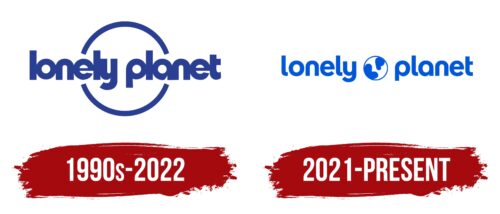The Lonely Planet logo, refreshed in 2022, brought forward a brighter shade of blue along with white, revitalizing the emblem’s color scheme. The design composition underwent slight modification, positioning a graphical depiction of the earth, showcasing blue landmasses set against a white sphere neatly nestled between the two segments of the wordmark. Furthermore, the typeface used for the inscription underwent a subtle transformation, characterized by a sleeker, lighter rendering of the letters and increased white space between them.
Symbolically, the emblem’s graphical element, a globe, conveys the company’s mission to serve as a comprehensive guide to the world’s most intriguing destinations. The choice of blue represents vastness and depth, symbolizing the limitless possibilities of travel. In contrast, white symbolizes purity and clarity, aligning with the brand’s commitment to providing clear, concise, and accurate travel information.
The change in typography with a thinner design and more space between the letters is a move toward a more modern and contemporary look. This design choice signifies the brand’s adaptability, reflecting its ability to evolve with the ever-changing world of travel.
Thus, the meaning behind the emblem Lonely Planet design of this iconic travel guide company can be seen as an embodiment of its purpose: to inspire and guide travelers, providing reliable and up-to-date information about every corner of our diverse planet.
Lonely Planet: Brand overview
| Founded: | 1973 |
| Founder: | Tony Wheeler, Maureen Wheeler |
| Headquarters: | Fort Mill, South Carolina, United States |
| Website: | lonelyplanet.com |
Established in Australia in 1973, Lonely Planet has earned a respected place in the world of travel guidebook publishing. Through the years, it has provided travel enthusiasts and wanderlust-driven readers with over 150 million books filled with engaging insights and invaluable guidance.
With its roots deeply planted in the vision of its founders, who once embarked on a transformative overland journey from Europe to Australia, this reputable guidebook publisher was born from genuine travel experiences. The founders’ initial venture, crafting a guide for fellow travelers trekking along the Asia overland trail, paved the way for a future enriched with detailed travel guides covering every continent.
Meaning and History
The brand identity of Lonely Planet is defined by its commitment to authentic travel experiences. Its guidebooks aren’t merely collections of popular tourist spots; they provide a deep dive into the culture, traditions, and offbeat paths of each destination. This authenticity, complemented by first-hand experiences and thorough research, is the cornerstone of the brand’s identity.
Another critical component of the brand’s identity is its inclusivity, which manifests in its broad range of guides. Whether it’s catering to the luxury traveler, the budget backpacker, the adventurous explorer, or the culinary tourist, it strives to cover every travel style. This approach of offering something for everyone amplifies its appeal to a diverse global readership.
At its core, the brand communicates a sense of adventure and discovery, inspiring readers to venture beyond their comfort zones. The imagery used in its promotional activities, from book covers to social media campaigns, encapsulates this spirit. By encapsulating the magic and allure of travel, the branding of Lonely Planet compels readers to embark on their own journeys, solidifying its status as a trusted companion for globetrotters.
What is Lonely Planet?
Lonely Planet, founded in 1973 by Tony and Maureen Wheeler, is one of the world’s most successful travel publishing companies. It is headquartered in Fort Mill, South Carolina, United States. Lonely Planet provides comprehensive travel guides that cover a multitude of destinations across the globe. These guides include information about sights, accommodations, restaurants, and travel tips, and they have become essential resources for travelers seeking independent, reliable travel advice. The company also produces phrase books, children’s titles, and a range of digital content, including apps, ebooks, and an active online community for travelers.
1990s – 2022
2021 – today
Lonely Planet color codes
| Tang Blue | Hex color: | #0057d9 |
|---|---|---|
| RGB: | 0 87 217 | |
| CMYK: | 100 60 0 15 | |
| Pantone: | PMS 2728 C |






